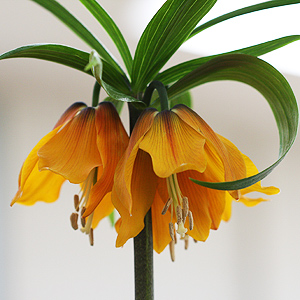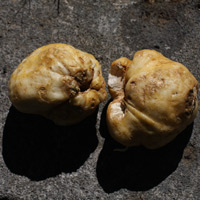
Fritillaria imperialis are the most spectacular of all of the species and are the largest growing of all of the frits growing to nearly 1m.
Also known as the ‘Crown Imperialis’ and ‘Crown Fritillary’ it can be grown in the garden or in a container.
The easiest way to grow this beautiful bulb is from a mature bulb purchased online. Best in USDA Zones 5 – 8, in some soils and climates they are very easy to grow, in others they can be difficult.
The flowers last for nearly a month and deserve a prominent position in the garden. As the bulb becomes larger, so do the flowers.
Flower colour varies, with the burnt orange being the most commonly grown. Yellow and red flowering varieties are also available, however these are rare.
Except perhaps the most hot and humid, no matter what zone you are in, you can grow these wonderful flowering bulbs. It may need to be in a container, however they are well worth the effort.
Fritillaria imperialis Care

Good drainage is essential, as is a deep fertile soil. These are a bulb that likes a sunny position although a little afternoon shade is also suitable.
Bulbs are best planted in late summer, this gives them time to commence root growth before winter.
How to Plant In a Container
- Choose a large deep container as these are heavy feeding bulb.
- The bulb will need to planted at around 4 – 8 inches deep. So allow for this when planting.
- In the bottom of the container, place some of the potting mixture.
- Around 8 inches from the top, place a good layer of fine to medium gravel, or sharp sand.
- You will notice that the bulb has a hole in the centre where last years stem was. This is the area that needs to be protected from rot. So plant the bulb on its side.
- Fill the container to the top with a high quality soil and compost mix with some blood and bone plus some lime mixed.
- Water in gently and set aside in a position protected from heavy rain.
- In spring the bulb will begin tho shoot. This is the time to commence fertilising and watering.
- We suggest using a liquid feed of seaweed fertiliser and top dressing with aged cow manure,. You can also use some sulphate of potash.
- Mulch highly around the stem once it appears.
- Allow the spent flower stem to die right back before removing.
Fritillaria imperialis Varieties
Like most other species, Fritillaria imperialis requires a well drained position to avoid bulb rot, and can be successfully grown in a container or pot.
The attractive mop top flower head ranges in color from the yellow of F. imperialis ‘Lutea’ to the more common orange. Native to Turkey, Iran and Afghanistan all prefer hot dry summers and cold winters.
F. imperialis is the crown prince of Fritillaria up to 1.5m with orange or yellow ‘Maxima Lutea’ drooping bell shaped flowers from the top of its tall stem. Fritillaria imperialis ‘Aureomarginata’ is a variegated form.
Varieties include:
Fritillaria imperialis Rubra – red flowers
Fritillaria imperialis ‘Aurora’ – Yellow Flowers
Fritillaria imperialis ‘Lutea Maxima (Very pretty yellow flowering form)
Fritillaria imperialis Rubra Maxima – Red flowers
Problems
- Bulbs Rotting
One of the major problems with Fritillaria imerialis is bulbs rotting in the ground. This can be overcome by improving drainage. - Not Flowering
A problem caused by the bulb not being planted deep enough.
Also caused by using slow release fertilisers.
- Small Flowers
Often caused by too much shade.
Also caused by small bulbs. Flower size will increase as the bulb matures.

